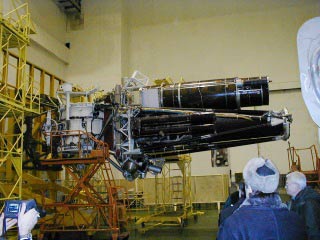The Spectrum-RG telescope helps to see 3 million galaxies
The Spectrum-RG astrophysical observatory project (scheduled to be launched in 2011) will have a target for space exploration with X-rays and gamma rays. Observing the entire sky for the first time with X-rays will allow the discovery of hundreds of thousands of ultra-black holes hiding, 3 million new galaxies are active and 100 thousand new galaxies.
Mikhail Pavlinski, deputy director of the Space Research Institute of the Russian Academy of Sciences, affirmed that the Spectrum-RG's new observation capabilities will allow for the exploration of the most complex problems of the universe.
The Spectrum-RG Observatory will include eRosita X-ray telescopes from Germany, a Lobster X-ray telescope that simulates lobster eyes with a wide view of the UK, many Russian instruments such as a focused telescope X-ray ART-XC, a GRBM machine detects gamma-ray bursts, a Spin-X X-ray telescope and a BLUS computer.

The observatory will be put into orbit by a Russian Soyuz-Fregat rocket. Two observation radio scenarios are currently being studied: Baikonour (Kazakhstan) with Souz-FG missiles from Korou (French Guyane) with Soyuz-ST missiles.
If Baikonour is selected, the observatory will be placed on a 600km high orbit at a tilt of at least 30 degrees. In the case of takeoff from Kourou, the orbit will have an altitude of 600km and a tilt of less than 5 o .
The take-off observatory will weigh nearly 2,100kg and is expected to operate for 7 years, with the possibility of an additional 10 years.
WITH
- The knot formed from two galaxies collided
- Russia launched a new space telescope
- Unique picture of 2 galaxies colliding
- Detecting a group of 'ghost galaxies'
- New Hubble telescope image of the hybrid galaxy UGC 12591
- Galaxies reach adulthood in hydrogen pools
- The European telescope spotted 72 new galaxies
- 5 most impressive galaxies in the universe
- 15,000 galaxies in the Hubble telescope image
- Two collision galaxies are 424 million light-years from Earth
- Kepler telescope officially retired at 151 million km from Earth
- Ancient galaxies are suitable for life
 Van Allen's belt and evidence that the Apollo 11 mission to the Moon was myth
Van Allen's belt and evidence that the Apollo 11 mission to the Moon was myth The levels of civilization in the universe (Kardashev scale)
The levels of civilization in the universe (Kardashev scale) Today Mars, the sun and the Earth are aligned
Today Mars, the sun and the Earth are aligned The Amazon owner announced a secret plan to build a space base for thousands of people
The Amazon owner announced a secret plan to build a space base for thousands of people